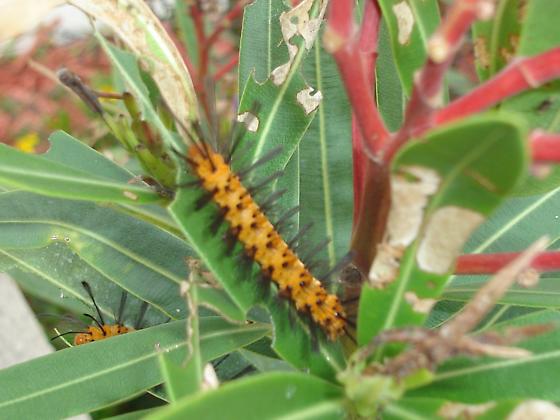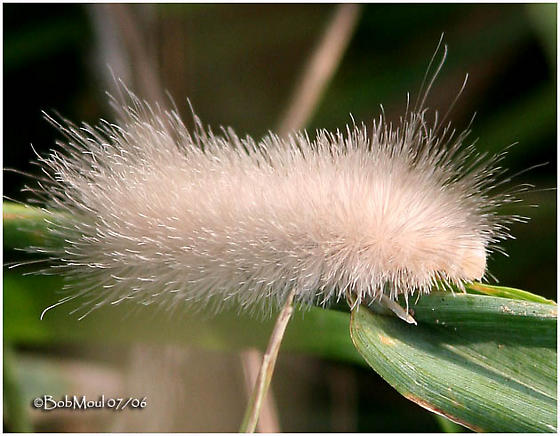Acoustic Mimicry
Biology 342 Fall 08
Ontogeny
From the Greek ont (being) and genesis (birth), ontogeny refers to the developmental history of an organism from conception until death. In Tinbergen's paradigm, it represents a proximate process defined by the sequential changes that an individual organism undergoes across its lifespan. The success of acoustic mimicry depends on such changes across the lifetimes of both moths and bats.
Importance of Learning and Experience
Historically, there has been much debate over the mechanism by which, sound producing moths deter bats (for more information on the various hypotheses see section on Adaptation). In 2005, Hristov and Conner created an experimental design that sought to distinguish between these various hypotheses. They de-coupled chemical unpalatability from sound production by exposing naive bats to different combinations of sound producing versus silent, and palatable versus unpalatable tiger-moth species. They found that naive bats did not learn to avoid sound-producing moths in the absence of chemical defense. In other words, sound production represents a true aposematic signal that warns bats about moth unpalatability. Individual bats, then, have to learn to associate moth clicks with an unfavorable food source. Insectivorous bats are generalist feeders and must therefore be capable of learning what prey are favorable in whichever environment they come upon (Ratcliffe et al. 2003). As many other animals, insectivorous bats have the ability to learn taste aversions, meaning they can quickly learn to avoid foods that have caused them harm or malaise (Ratcliffe et al. 2003). These taste aversions are not innate, they must be learned over the course of a bat’s lifetime. As we will see, this will have important consequences for acoustic signaling in both model and mimic species.
The Importance of Diet and Life History
Moth unpalatability is often highly dependent on the type and quality of their larval food source (Hristov and Conner, 2005b). While some moths do produce noxious chemicals on their own, many acquire them from plants as larvae (Hristov and Conner, 2005b). In some species of moth, the chemicals are then sequestered in the body and retained throughout thelifespan (Hristov and Conner, 2005b). Adult palpability, then, can be highly dependent  on larval diet (Hristov and Conner, 2005b). Behaviors at key points in the lifespan maydetermine the potency and/or presence of chemical defenses. For instance, Maternalbehaviors will governwhere larvae are laid and therefore whether they have access to plants with the appropriate chemicals. Insome moth species, adults must maintain their unpalatabiltiy by continuing to feed on such plants. Chemical defense, then, represents the interplay between an organism’s physiology and its environment. Remember that under the aposematic hypothesis, moth sound production was necessarily paired at some with chemically driven unpalatability in order to function as an active deterrent against bats (Hristov and Conner, 2005b). As we have seen that many species of moth are not born with such chemical defenses, we can appreciate the importance that life history has played in creation and maintenance of aposematic signaling.
on larval diet (Hristov and Conner, 2005b). Behaviors at key points in the lifespan maydetermine the potency and/or presence of chemical defenses. For instance, Maternalbehaviors will governwhere larvae are laid and therefore whether they have access to plants with the appropriate chemicals. Insome moth species, adults must maintain their unpalatabiltiy by continuing to feed on such plants. Chemical defense, then, represents the interplay between an organism’s physiology and its environment. Remember that under the aposematic hypothesis, moth sound production was necessarily paired at some with chemically driven unpalatability in order to function as an active deterrent against bats (Hristov and Conner, 2005b). As we have seen that many species of moth are not born with such chemical defenses, we can appreciate the importance that life history has played in creation and maintenance of aposematic signaling.
(Top Right--Oleander caterpillar (Syntomeida epilais) eating toxic oleander; image courtesy of http://bugguide.net/node/view/110912/bgimage. Bottom Left--Cycnia tenera caterpillar; image courtesy of http://bugguide.net/node/view/62151/bgimage.)
Location, location, location
As mimic species produce sound, but do not possess chemical defenses a bat surrounded by mimics would never learn to associate sound production with unpalatability. Mimics are therefore playing what seems to be risky game by all accounts acting as stuffed shirts, unable to follow through with their threats. However, as prior experience with sound producing and chemically defended species is all that is needed to deter a bat from eating clicking moths, mimics need only ensure that they are encountering bats who have experience with noxious, sound producing moths. Location is key. For these mimic species to be successful they must remain sympatric with the model that they are copying. Individual moths who travel too far outside a given area, may find themselves face to face with bats encountering clicking moths for the first time. Similarly, the females of these mimic species who fail to deposit their larvae in appropriate locations doom their offspring.